“Who are these that fly along like clouds, like doves to their nests?”
Isaiah 60:8 (NIV)
“I’ve been to Reagan National Airport. I tell people it was named after me.”
Ron Reagan
Exploring the Purpose of Your Work and Corporation
Have you ever considered the true purpose behind your work and the mission of your corporation? In this chapter, we delve into the profound significance of your endeavours and how they contribute to the aviation and tourism industry, particularly in the enchanting region of Borneo.
Your Work’s Purpose:
1. Pioneering a Unique Business Model:
- Your ambition is to ascend as a leader in the low-cost carrier terminal (LCCT) industry, presenting a business model like no other.
2. Establishing a Profitable LCCT:
- The cornerstone of your strategy is the creation of a new and prosperous low-cost carrier terminal (LCCT). Your aim is not only to meet secured demands but also to ensure financial viability and operational excellence.
As the purpose of your work aligns with your corporation’s mission, you embark on a journey that promises to revolutionize the aviation and tourism industry. Ultimately, your efforts will bring joy to the 12 million visitors who will have the privilege of discovering and cherishing the natural beauty of this tropical paradise.
One of the pioneers of low-cost carrier terminal. The former Kuala Lumpur International Airport Low-cost carrier terminal.

1.0 Executive Summary
Mission:

Key Management Team:
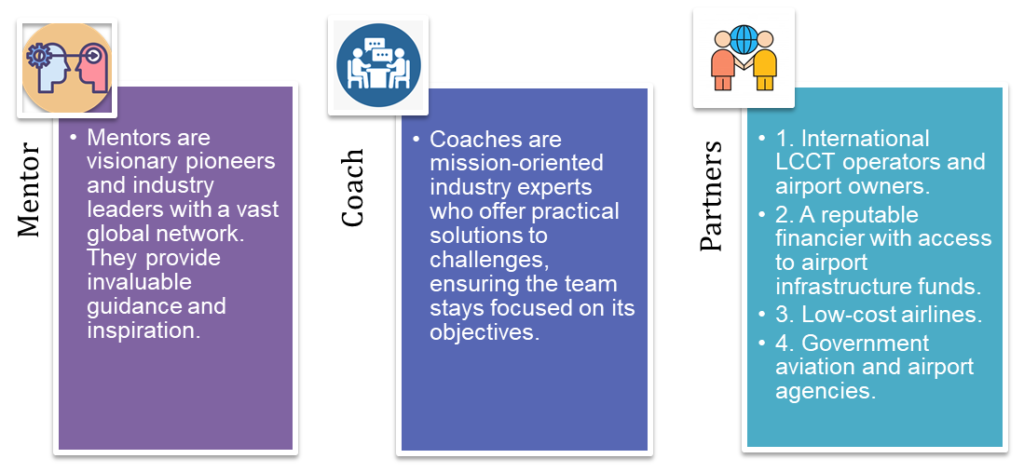
Product Benefits:

Target Market:
- Passengers: The target market consists of low-cost airlines serving approximately 12 million passengers from North Asia, India, and the Middle East.
Financial Projections:

Unique Business Model:
- Strategic Partnerships: Collaborations with low-cost airlines to secure access to the target passengers.
- International LCCT Operators: Partnering with international LCCT operators to enhance the chances of success and profitability.
- Alignment with Tourism Stakeholders: The strategic alignment with destination tourism and hospitality stakeholders will facilitate horizontal and vertical integration.
- Private Equity Airport Investors: Collaboration with private equity airport investors to enhance the business and financial excellence.
- Market Leadership: The powerful team can aspire to become the market leader in the tourism industry in Borneo.
2.0 Mission
2.1 Problem

2.2 Solution:
- The proposed solution involves the establishment of a new, full-service international airport in Kimanis, Sabah, as a joint effort between the government and private sector investment.
2.3 Mission:
- The mission is to create a new entity and forge strategic alliances with low-cost airlines, international LCCT operators, airport investors, and government aviation agencies.
- The aim is to invest in the development of the new LCCT in Kota Kinabalu to cater to the needs of the target international tourists.
3.0 Product
3.1 Product Description:
- The LCCT is designed to accommodate low-cost airlines, with a focus on serving 12 million target tourists.
- The primary objective of the LCCT is to provide efficient services at a competitive cost.
- The LCCT is equipped to handle low-cost airlines and dedicated aircraft such as the A320 and B737.
3.2 Product Attributes:
- The new LCCT will streamline the check-in process, reduce heat-related issues, and maintain efficient baggage handling.
- Supporting facilities will be in place to enhance quick turnaround times and minimize maintenance requirements.
- The design of the LCCT is scalable, initially catering to 7.5 million tourists and with the capacity to expand to accommodate 12 million passengers.
3.3 Product Benefits:
- The LCCT is projected to reduce operating expenses by an estimated 25–35%, with these savings being passed on to low-cost airlines and their passengers.
- The strategic partnerships will ensure that low-cost airlines have access to full capacity, optimizing their operations.
3.4 Product Competitive Advantages:
- Meeting Needs: The LCCT is tailored to serve low-cost airlines with a target passenger base of 12 million.
- Financial Viability: Financial viability is secured through collaboration with airport financiers and investors.
- Operational Excellence: The LCCT benefits from the expertise of an experienced international LCCT management group.
4.0 Market
4.1 Market Segment:
North Asia: China, Japan, Korea, Taiwan, and Hong Kong. India: Mumbai, Delhi, Chennai, Hyderabad, Bangalore, Kolkata. Middle East: Qatar, Kuwait, Saudi Arabia, Bahrain and Turkey.
4.2 Target Market Strategy:
- Create a high demand for aircraft landing and departure.
- Cater to the high passenger utilization of the LCCT.
- Offer rapid turnaround times at airports, with a target of 25 minutes.
- Implement lower Passenger Service Charges (PSC) and taxes to attract price-sensitive tourists.
- Design facilities tailored to budget tourists.
- Focus on point-to-point services.
- Provide high-quality amenities such as toilets, food courts, supermarkets, and other essential services.
- Cater to short-to-medium routes within 3-7 hours of flight.
- Position the LCCT as the low-cost second-tier airport complementary to the full-service primary airport.
4.3 Market Needs:
- In 2019, Borneo attracted 3 million international visitors.
- In Phase 1 (5 years), projection is 5 million air passengers, equivalent to 86 flights per day for Boeing 737/Airbus A320 planes.
- Phase 2 (10 years) will see 7.5 million air passengers, translating to 129 flights per day.
- At full capacity (15 years), the LCCT will aim to serve 12 million air passengers, with 207 flights per day.
4.4 Growth Drivers: our growth will be driven by factors such as:
- Increasing income levels in the middle class in our target cities.
- Favourable currency exchange rates in Borneo.
- The establishment of unique tourist attractions at our destinations.
4.5 Key Players:
1. Key local Airport / Owner / Operator
Brunei International Airport: Government of Brunei / Department
of Civil Aviation
Kuching International Airport: Government of Malaysia / Malaysia
Airports Holdings
Kota Kinabalu International Airport: Government of Malaysia /
Malaysia Airports Holdings
Indonesia Airports: Angkasa Pura I and II manage the 26 largest
airports and the Ministry of Transport that
manages over 200 airports.
2. Key Customers - Low-Cost Carriers in Asia and the Middle East 9 Air AirAsia Air Busan Air India Express Air Seoul Beijing Capital Airlines China Southern Airlines China United Airlines Eastar Jet Flydubai Go First IndiGo Jeju Air Jin Air Lion Air Loong Air Lucky Air Peach Aviation Pegasus Airlines Ruili Airlines Shanghai Airlines SpiceJet Spring Airlines West Air Urumqi Air Xiamen Air
4.6 Competition and Industry:
In terms of competition and industry benchmarks, the following were recognized as the world’s top low-cost airline terminals in 2018 (Skytrax Awards):
- Berlin Schonefeld
- Brussels Charleroi
- East Midlands
- Frankfurt-Hahn
- Kansai – T2
- Kuala Lumpur – KLIA2
- London Stansted
- Luton
- Melbourne – T4
- Tokyo Narita – T3
Additionally, the following were ranked as the world’s top 10 airports (Skytrax Awards):
- Centrair Nagoya
- Doha Hamad
- Germany Frankfurt
- Germany Munich
- Hong Kong
- London Heathrow
- Seoul Incheon
- Singapore Changi
- Switzerland Zurich
- Tokyo Haneda
4.7 Borneo’s Competitive Advantages:
Borneo offers several competitive advantages, including:
- KKIA: Kota Kinabalu airport serves as a favoured hub for tourists from North Asia, with over 15 existing point-to-point connections.
- Capacity: The existing facilities can be expanded to accommodate 12 million passengers.
- Location: The existing airport is conveniently located within a 15-minute drive from the city, enhancing accessibility for travellers.
5.0 Operation
5.1 Planning Strategies:
The operational planning strategies are designed to maximize profitability through efficiency while providing essential services to passengers. Key points include:
- Goal: Achieving higher profitability with efficient operations and a focus on essential services.
- Capacity: Preparing to handle 12 million passengers annually, equivalent to 207 flights per day.
- Plan: Converting and extending the existing building to facilitate single-floor operations for both departure and arrival passengers. This will involve the use of airport buses and airstairs.
- Facilities: Providing quality amenities such as toilets, a food court, supermarket, telecommunication shop, car rental services, currency exchange, ground transportation options, and other essential services.
- Parking: Increasing off-site parking capacity while optimizing traffic flow, including converting kerbside areas.
- Design: Implementing a refurbished design that eliminates the need for escalators and aerobridges, minimizes heat load, lowers ceiling heights, and incorporates features like automated check-in and immigration gates.
5.2 Time:
The operational goal is to achieve a rapid turnaround time of just 25 minutes for flights, ensuring efficient use of resources and timely departures.
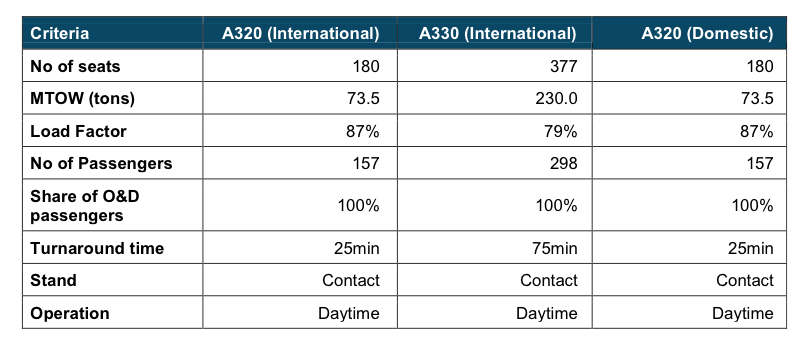
5.3 Airport Layout:
The airport layout plan will aim at optimizing passenger flow and operational efficiency. This includes provisions for efficient passenger processing, minimization of escalator and aerobridge usage, and other design elements that enhance the overall passenger experience.

6.0 Financial Implications
6.1 Investment Segments:
1. Aeronautical: Revenues are airline rents and landing fees, passenger
service and aircraft parking. The income is from the
fee per passenger and aircraft size for the use of the
runways, terminals, and facilities.
2. Others: Incomes are from retail rentals airport advertising, car
park rental and others.
Investment
LCCT: Convert existing Kota Kinabalu Airport into a low-cost secondary airport

6.2 Cost of Production:
Projected operation cost

Case studies
1. Indonesia • Hang Nadim Airport: US$275 million • Singkawang Airport: US$305 million • Tarakan Airport: US$91 million • Lombok Airport: US$995 million • North Bali Airport: US$1.9 billion • Kualanamu Airport: US$1.4 billion • Soekarno Hatta 2 Airport: US$10.4 billion
2. Sarawak • Lawas airport: US$120 million
3. Sabah
• Sandakan airport: US$20 million upgrade
• Kimanis new airport: Estimated US$900 million/30 million
passengers capacity
4. Low-cost carrier terminal (LCCT) in Asia and Oceania
• Ben Gurion Airport: US$840 million upgrade/35 million
passenger capacity
• Changi T4: US$733 million in 2017/16 million
passengers capacity
(A new direction for low cost and fully
serviced terminal)
• Don Mueang Airport: US$1.2 billion upgrades in 2019/40.7
million passengers in 2018
• Indira Gandhi Airport T1: US$1.3 billion expansion for airport/100
million capacity, including 30 million
passengers capacity for T1
• Kansai Airport: US$20 billion 2008/28 million
passengers in 2017
• Kuala Lumpur Klia2: US$1.3 billion 2014 /45 million
passengers
• Kota Kinabalu Airport: US$368 million in 2005 value/12 million
passengers capacity
• Melbourne Terminal 4: US$730 million in 2015/10 million
passengers capacity
• Narita Airport T3: US$137 million in 2015/7.5 million
passenger capacity
• Sepang LCCT: US$30 million in 2006/10 million
passenger capacity (Ceased)
• Singapore T4: US$733 million in 2017/16 million
passengers capacity
• Soekarno-Hatta T1 & T2: Refurbishment $256 million 2018/36
million passengers capacity for T1 & T2.
5. Other fully serviced international airports
• Al Maktoum Airport: US$37.1 B/260 M passengers capacity
• Beijing Daxing Airport: US$13 B 2019/200 M passengers capacity
• Denver's Airport: US$8.6 B in 2021 value/33.7 M passengers
• Heathrow Airport: US$18.5 B/130 M passengers capacity
• Hong Kong Airport: US$20 B/72 M passengers in 2019
• Istanbul Airport: US$36 B/200 M passengers capacity
• JFK Airport: US$13 B/62.5 M passengers in 2019
• Kansai Airport: US$20 B in 2008/28 M passengers in 2017
• LA Airport: US$14 B/88 M in 2019
• Mexico City Airport: US$13 B/125 M passengers capacity
• Sydney Airport: US$16.7 B bid in 2021/43 M passengers
in 2019
6. Landing and parking charges in Asia
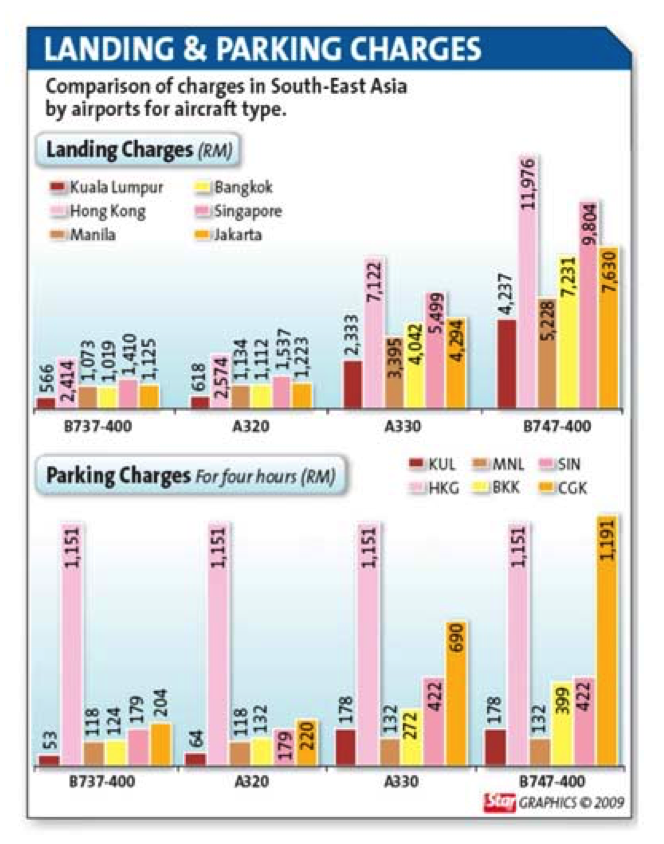
7. Compare to selected Australian airports: Aeronautical expenses per passenger in 2018 Brisbane Airport: US$6.58 per passenger Sydney Airport: US$7.99 Melbourne Airport: US$5.73 Perth Airport: US$7.40 Heathrow Airport: US$19.00 Global average: US$13.55
6.3 Prices and Revenues:
Projected yearly revenue for the new LCCT in Kota Kinabalu:


Case studies
1. Current income for Kota Kinabalu International Airport: • Car parking = US$6 / day (1,400 car parks. New LCCT will increase to 2,000 car parks.) • Shop rental = Up to US$450 / m2 / month
2. International example: The total revenue of airports is derived from: Aeronautical revenue: 56% non-aeronautical revenue: 40% Non-operating revenue: 4% Global aeronautical revenue: US$10.15/Passenger Global non¬aeronautical revenue: US$7.12/passenger Global average revenue: US$17.27/passenger
3. Malaysia: PSC, landing charges and parking fee

4. Malaysia example: Average revenue per passenger 2017

Income breakdown: PSC: 80% Landing fee: 19% Aircraft parking fee: 1% PSC is currently US$12.06–US$17.61 / passenger for international destinations.
5. Revenue per passenger for selected airports with Skytrax Airport Ranking, 2011–2018
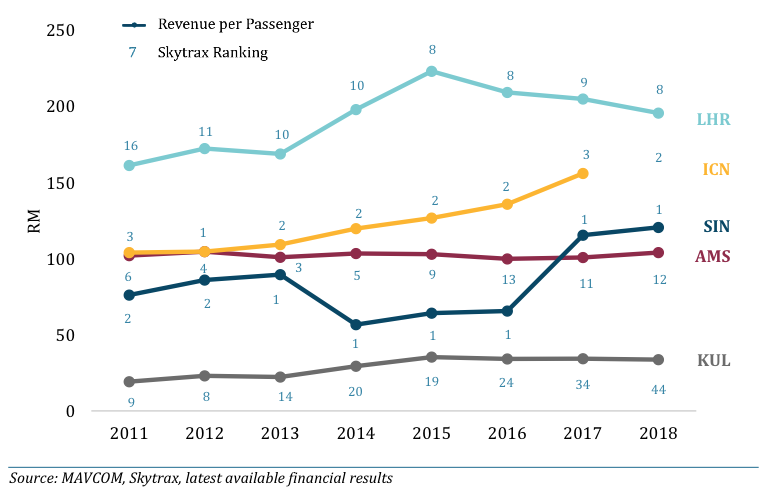
6.4 Financial Returns:

Case studies
Case 1: 2018-2019 Selected Australian airports financial returns (A$) Revenue per passenger: US$9.58–US$14.54 Return on assets: 7.2%–12.5% (aeronautical) Operating profit margins: 48.1%–59.5%
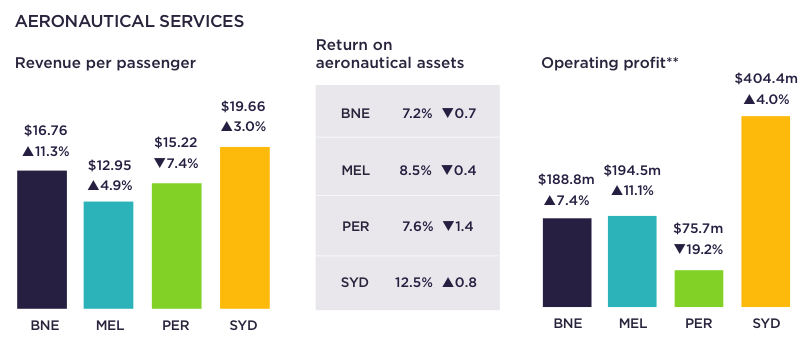
Case 2: Expansion of Hang Nadim International Airport Passenger Terminal Batam Island
Estimated cost: US$448 million
FIRR: 18%
NPV: US$151.0 million
Concession period: 25 years
Case 3: Kodomo International Airport/2021
Estimated cost: US$87 million
IRR : 11%
NPV : US$22.5 million
Concession period: 25 years
Case 4: Singkawang Airport West Kalimantan/2021
Estimated cost: US$127 million
IRR: 12.3%
NPV: US$15.38 million
Concession period: 32 years
Case 5: Kediri Airport East Java/2021
Estimated cost: US$596 million
IRR: 9.48%
NPV: US$58.55 million
Concession: 50 years
Case 6: Selected international airports Airport size of fewer than 1 million passengers was not profitable.
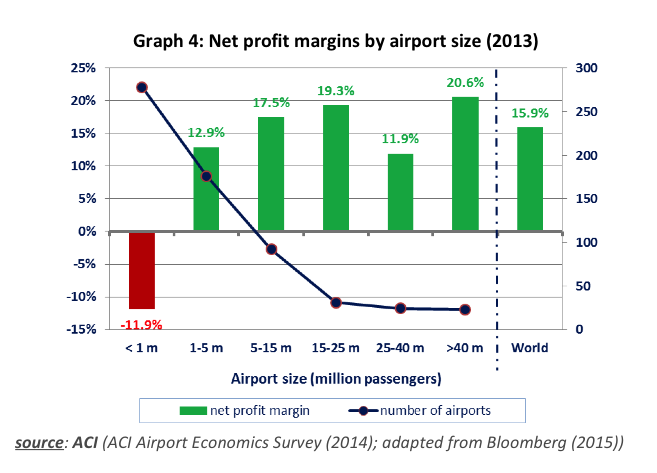
Airport Industry net profit margin and return on invested capital 2017
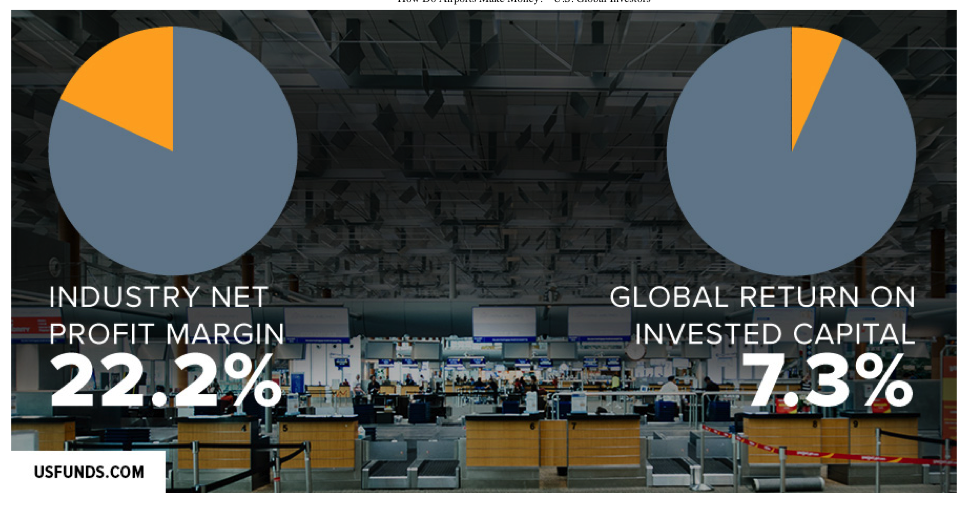
2019 Financial Income of of public listed airport companies:
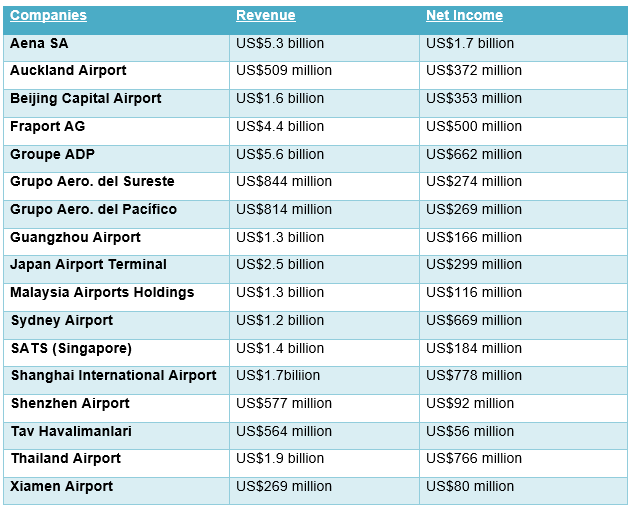
6.5 Source of Funding:
1. Strategic investors
• New investor: Project leader with a focus on LCCT business and
financial goals.
• Financier: Airport private equity groups seeking stable
return through long-term market cycle.
• Airport operator: International low-cost carrier terminal (LCCT)
operators.
• Target market: New virtual airlines and other low-cost airlines.
2. Private equities and investors
1832 Asset Management Aberdeen Asset Managers AENA Alinda Capital Partners AMP Capital Investors APG Asset Management Apollo ARGA Investment Management Atlas Infrastructure Partners AviAlliance Banque de Luxembourg Investments BC Investment Management Black Creek Investment Management BlackRock Blackstone Brookfield Asset Management Caisse de dépôt et placement du Québec Capital Research & Management Causeway Capital Management Changi Airport International (CAI) Children’s Investment Fund China Life Asset Management China Investment Corporation China Merchants Fund Management China Southern Asset Management China Universal Asset Management Citi Infrastructure Investors Clearbridge Investments Cohen & Steers Capital Management Comgest SA, Corporación América Corporación Financiera Alba Da Cheng Fund Management Deka Investment Dimensional Fund Advisors DWS Investment E Fund Management F2i Fidelity Management & Research First Eastern Investment Group First Sentier Investors Flughafen Zürich Fraport, Fremont GAM Investment Management GF Fund Management GIC Global Infrastructure Partners Goldman Sachs Asset Management Grupo Ferrovial Handelsbanken Asset Management Hermes Investment Management Horizon Kinetics Asset Management H.R.L Morrison HuaAn Fund Management Huatai-PineBridge Fund Management IFM Investors Invesco Advisers KKR Krung Thai Asset Management Krungsri Asset Management Macquarie Infrastructure and Real Assets Magellan Group Massachusetts Financial Services Matthews International Capital Management Mellon Investments, MFC Asset Management Mitsubishi UFJ Financial Group Mizuho Financial Group Morgan Stanley Infrastructure Partners Neuberger Berman Ninety One UK Norges Bank Investment Management Nomura Asset Management Oaktree One Investment Group Penghua Fund Management PineBridge Investments Asia Principal Asset Management Qatar Investment Authority Schiphol Group Schroder Investment Management Shanghai Greenwoods Asset Management T. Rowe Price TCI Fund Management Temasek Holdings Thornburg Investment Management TMB Asset Management Union Investment Privatfonds US Global Investors Utilico Emerging Market Vanguard Group Veritas Asia Pacific Vinci Airports Wasatch Advisors Weston Hill Equity Holdings Whitehelm Capital William Blair Investment Management Zhong Ou Asset Management.
3. Consultants, development and funding managers for the timber plantation industries:
Aéroports de Paris
Airport Consultants Council (ACC)
Airport Council International (ACI)
Airport Planning Ltd
Airport Services Association (ASA)
Atlantia Group, Aviation Strategies International (ASI)
BCG
CAPA
Civil Aviation Authority of Malaysia (CAAM)
Corporacion America Airports
Deloitte
Ernst & Young
GMR Group
International Air Transport Association (IATA)
InterVISTAS Consulting
KPMG
Landrum & Brown
Malaysia Airport Holdings
Malaysian Aviation Committee (Mavcom)
McKinsey
Morningstar
Mott Macdonald
PWC
Wiedemann Consultants
6.6 Value Proposition
Savings: Price-sensitive tourists are always looking for the best deals when it comes to travel expenses. The virtual airline’s strategic partnership with low-cost airlines and LCCT will offer the most competitive pricing structure, ensuring that travellers save significantly on their journeys.
Spending: The approach recognizes that North Asian tourists are inclined to allocate their budget towards experiencing destination attractions, savouring local cuisine, and indulging in shopping. The aim is to enhance their travel experience by providing cost-effective options for transportation, allowing them to allocate more of their budget to what truly matters to them.
Investment: The stakeholders as integral parts of an integrated development group within tourist destinations. By collaborating in the development of shopping malls, food centres, and hotel properties, opportunities are created for stakeholders to maximize their returns on investment. This approach aligns their interests and fosters mutual growth within the tourism industry.
7.0 Management Team
7.1 Key Management Team
- Mentor:
Mentors are visionary pioneers and industry leaders with a vast global network. They provide invaluable guidance and inspiration.
- Coaches:
Coaches are mission-oriented industry experts who offer practical solutions to challenges, ensuring the team stays focused on its objectives.
- Partners:
1. International LCCT operators and airport owners.
2. A reputable financier with access to airport infrastructure funds.
3. Low-cost airlines.
4. Government aviation and airport agencies.
In the airport industry, several global leaders have made significant contributions, shaping its growth and success. Here is a list of some of these remarkable individuals, honoured for their vision and dedication:
- Professor Norman Ashford
- Tony Fernades
- Professor Anne Graham
- Paul Griffiths
- Lee Seow Hiang
- Professor Peter Morrel
- Dr Daniel Prather
- Stewart Wingate
These are just a few of the outstanding professionals and captains of the industry. The readers are encouraged to explore further and conduct their research to learn more about the management teams in this dynamic field.
7.2 Key Management Team Model
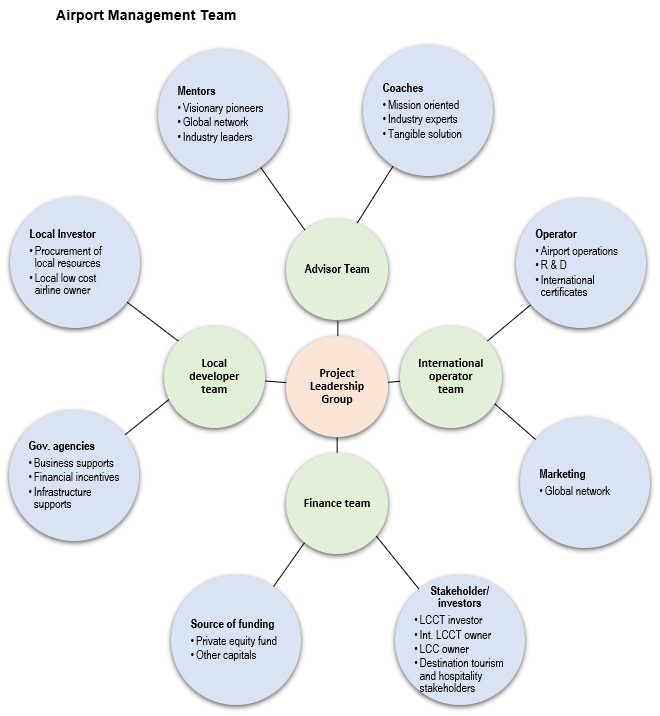
8.0 Unique Business Model
8.1 Successful Track Record
- Project Team: The project team will be selected from the top-tier airport management groups with impeccable track records in airport operations, infrastructure finance, international airline network collaboration, and working with government agencies.
- Top Airports: The team will draw inspiration from some of the world’s leading airports in 2021, including Doha Hamad, Tokyo Haneda, Singapore Changi, Seoul Incheon, Tokyo Narita, Munich Airport, Zurich Airport, Kansai Airport, and Hong Kong Airport.
- Top LCCTs: The tem will study and learn from top low-cost airline terminals in 2018, such as Kansai–T2, Tokyo Narita –T3, Melbourne–T4, Kuala Lumpur–KLIA2, London Stansted, Brussels Charleroi, East Midlands, Luton, Berlin Schonefeld, and Frankfurt-Hahn.
- Top LCCs: The business model will take into account top Asia low-cost airlines, including AirAsia, Citilink, Flynas, Indigo, Lion Air, PAL Express, Scoot, and Vietjet Air.
- Top Investors: The team will aim to engage with leading airport investors like Utilico Emerging Markets, Children’s Investment Fund, Groupe ADP, Fraport, Vinci Concessions, Groupo Ferrovial, Morgan Stanley, AENA, Corporación Financiera Alba, TAV Airports, Corporación América, Cedicor, Citigroup, PSP Investments, and Changi Airport Group.
8.2 Entry Model
Business model, Ebitda performance and service quality rating of selected airports.
Entry model options.

The entry model involves refurbishing an existing airport and transforming it into a low-cost carrier terminal (LCCT). This model combines affermage/lease and concession operating agreements, ensuring a mutually beneficial partnership. Key details include:
- Time: The team will propose a long-term concession period of 50 years.
- Ownership: The government retains 100% asset ownership.
- Regulatory: Government retains regulatory authority.
- Management: The private investor takes full control, bearing the risk and responsibility.
- Capex: The private investor is responsible for development, Capex, and operation expenses.
- LBO: Lease, build, and operate conditions are to be included in the contract.
- Financial: The private sector oversees overall financial management.
8.3 Unique Business Model
The unique business model is characterized by:
- Strategic Partnerships: The team will prioritize strategic partnerships with low-cost airlines to secure access to our target passengers.
- International LCCT Operators: Collaborating with international LCCT operators enhances the chances of success and profitability.
- Alignment with Tourism Stakeholders: Alignment with destination tourism and hospitality stakeholders reinforces horizontal and vertical integration.
- Private Equity Investors: Engaging private equity airport investors enhances the business and financial excellence.
- Powerful Team: The team will become the market leader in the tourism industry in Borneo, leveraging the combined expertise and resources.
Business models examples of selected airports
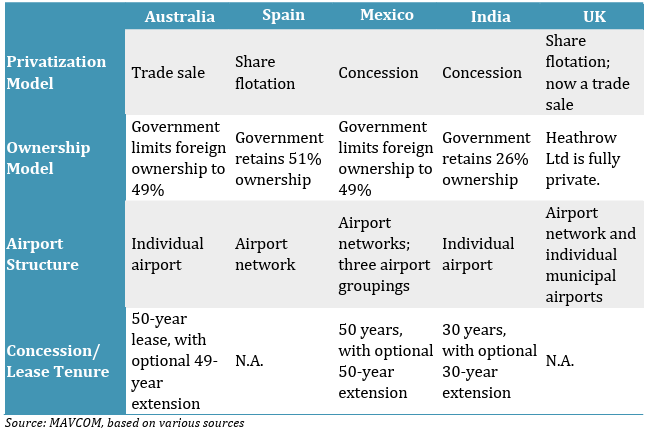
9.0 Key Success Factors & Risk Mitigation
9.1 Key Success Factors
- Commercial Autonomy: Ensuring commercial autonomy enables flexibility in decision-making and strategic partnerships.
- Independent Impartiality Regulators: Independent regulatory oversight ensures fairness and transparency in airport operations.
- Private Investor Initiative: Active private investor involvement in airport charges and financial management promotes efficiency.
- Strong Corporate Governance: Maintaining strong corporate governance practices enhances accountability and sustainability.
- Professional Investors and Management Team: The presence of professional investors and a management team with a proven global track record contributes to overall success.
9.2 Risk
- Disruption: Risks associated with epidemics, terrorist attacks, and environmental disturbances can disrupt operations.
- Regulations: Economic regulations can exert pressure on returns on capital.
- Competition: The emergence of a new hub airport in Kimanis may pose a competitive threat.
- Distress: Airlines under distress, withdrawals, or bankruptcies can impact operations.
- Social: Social impacts on the local community need to be managed effectively.
9.3 Risk Mitigation
- Disruption: Disruptive events are often short-term impacts. Strong financial backing and a long-term growth perspective can help weather such events, as passengers tend to return when conditions stabilize.
- Regulations: Implementing airport quality programs and maintaining strong governance practices can help the airport attain regulatory compliance and demonstrate due diligence.
- Competition: Focusing on point-to-point connections between origin and destination airports can help maintain competitiveness.
- Distress: Targeting multiple low-cost airlines reduces the risk of reliance on a single airline, mitigating the impact of airline distress.
- Social: Effective communication and engagement with local communities can foster positive social impacts, particularly through job creation in the tourist industry.
10.0 Exit Strategy
10.1 Forms of Exit
- IPO (Initial Public Offering): Investors sell their shares as part of the IPO to the public.
- M & A (Mergers and Acquisitions): Strategic acquisition by another airport investor.
- Sale: Investors sell to another private equity firm.
- Buyback: The management company buys back the equity stake from private investors.
10.2 Benefits of the Business to New Investors
- Market: Access to target passengers from North Asia, India, and the Middle East with a growing middle class.
- Revenue: Potential for revenue growth with the expansion of target markets.
- Price: Lower passenger charges and aeronautical expenses can enhance profitability.
- Risk: Secure demand and predictable expenses reduce risk exposure.
- Product: Opportunity for new route expansion to capture additional markets and generate extra revenue.
- Exit: Exit time is planned after the fifth year, marking the first milestone of business and cash flow.
10.3 Attraction of the Business to New Investors
- Market: Capture additional market share in the Asia Pacific regions.
- Cost: The new acquisition offers the opportunity to reduce costs and improve performance.
- EBITDA: Capitalize on competitive advantages through vertical integration, improving the bottom line.
- Leadership: Benefit from a new leadership team that can enhance business and financial performance.
- Distribution: Gain access to new markets and distribution channels.
- Revenue: Generate additional revenue through the new acquisition.
10.4 Winning Strategy
- Strategy: Implement a vertical integration model and build strong business alliances with stakeholders.
- Team: Assemble a powerful management team with the expertise to execute the strategy effectively.
- Win-Win: Create a profitable business model that rewards all stakeholders through revenue sharing and mutual success.